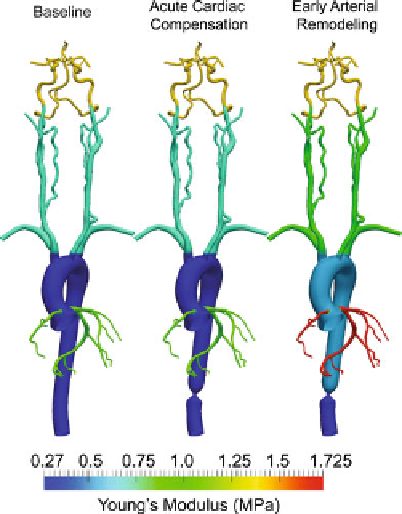Biomedical Engineering Reference
In-Depth Information
Fig. 15.3
Sections of the
model with different wall
properties. The acute cardiac
compensation frame refers to
the introduction of
coarctation and subsequent
cardiac compensation, the
early arterial remodeling
shows the differential
stiffening observed in animal
experiments in various
vascular regions. From
Coogan et al. (
2012
)
15.2.3.4 Vessel Wall Properties
Given current limitations in experimental data on regional variations in vascular
mechanical properties and thickness, four sections of the vasculature were endowed
with different but uniform wall properties, reflected by an effective constant stiff-
ness and thickness of the wall (Fig.
15.3
). The stiffness of the thoracic aorta was
chosen to yield physiologic levels of strain over normal ranges of blood pressure
(Redheuil et al.,
2010
) whereas moduli for coronary, neck, and cerebral vessels were
based directly on data (Gow and Hadfield,
1979
; Hayashi et al.,
1980
; Nichols and
O'Rourke,
2005
). The thickness of the vessel in each section was assumed to be
10 % of the mean radius within that section (Nichols and O'Rourke,
2005
).
15.2.4 Acute Cardiac Compensation Following Coarctation
When first introducing the coarctation, parameters for the heart model were modi-
fied to simulate an acute cardiac compensation. This modification accounted for the
increased work required of the heart to compensate for the increased afterload due
to the coarctation. If the heart were not to adapt, then cardiac output would decrease
due to the increased resistance in the aorta. Thus, the heart model was modified by
iteratively increasing values of the maximum left ventricular elastance and left atrial
pressure until cardiac output equaled that of the baseline model (Taylor and Donald,












































